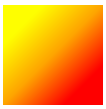Here is an example of how to use a LinearGradient Brush to fill a rectangle for example:
Xaml
<Rectangle x:Name="MyRect" Width="100" Height="100">
<Rectangle.Fill>
<LinearGradientBrush StartPoint="0,0" EndPoint="1,1" >
<GradientStop Color="Yellow" Offset="0.2"></GradientStop>
<GradientStop Color="Orange" Offset="0.5"></GradientStop>
<GradientStop Color="Red" Offset="0.8"></GradientStop>
</LinearGradientBrush>
</Rectangle.Fill>
</Rectangle>
C#
LinearGradientBrush gradient = new LinearGradientBrush();
gradient.StartPoint = new Point( 0, 0 );
gradient.EndPoint = new Point( 1, 1 );
GradientStop color1 = new GradientStop();
color1.Color = Colors.Yellow;
color1.Offset = 0.2;
gradient.GradientStops.Add( color1 );
GradientStop color2 = new GradientStop();
color2.Color = Colors.Orange;
color2.Offset = 0.5;
gradient.GradientStops.Add( color2 );
GradientStop color3 = new GradientStop();
color3.Color = Colors.Red;
color3.Offset = 0.8;
gradient.GradientStops.Add( color3 );
MyRect.Fill = gradient;
We define the gradient and set its StartPoint and EndPoint properties. They are logical points, which means that the point 1,1 has coordinates 100,100 inside the rectangle or we have a point with coordinates 1 time the width of the rectangle and 1 time the height of the rectangle. In this case the gradient will be displayed diagonally, but with this two properties you can place as you please. After that we define the GradientStops and set their colors and offsets. The Offset property is used to determine where the gradient stop will have a solid color and is applied to the length of the gradient.

That's it!